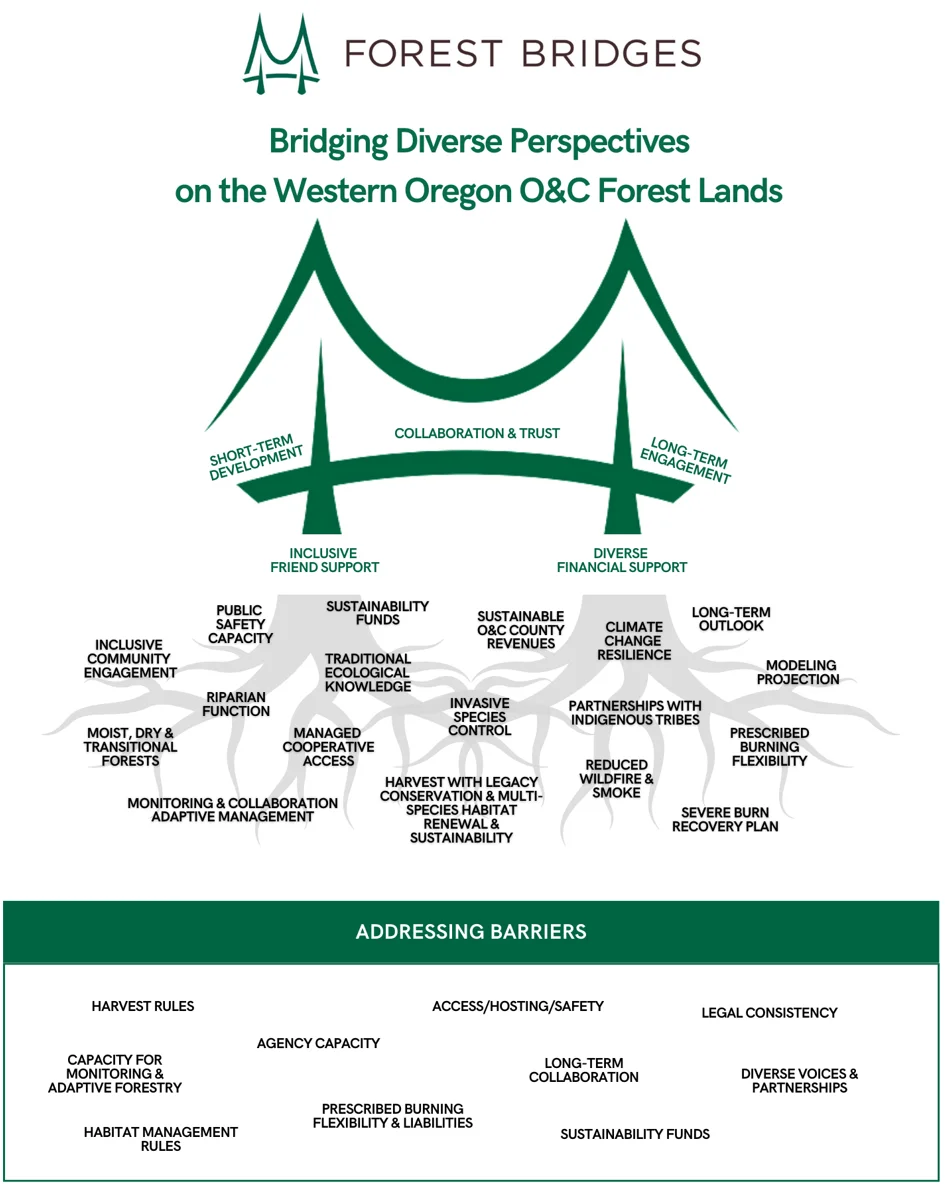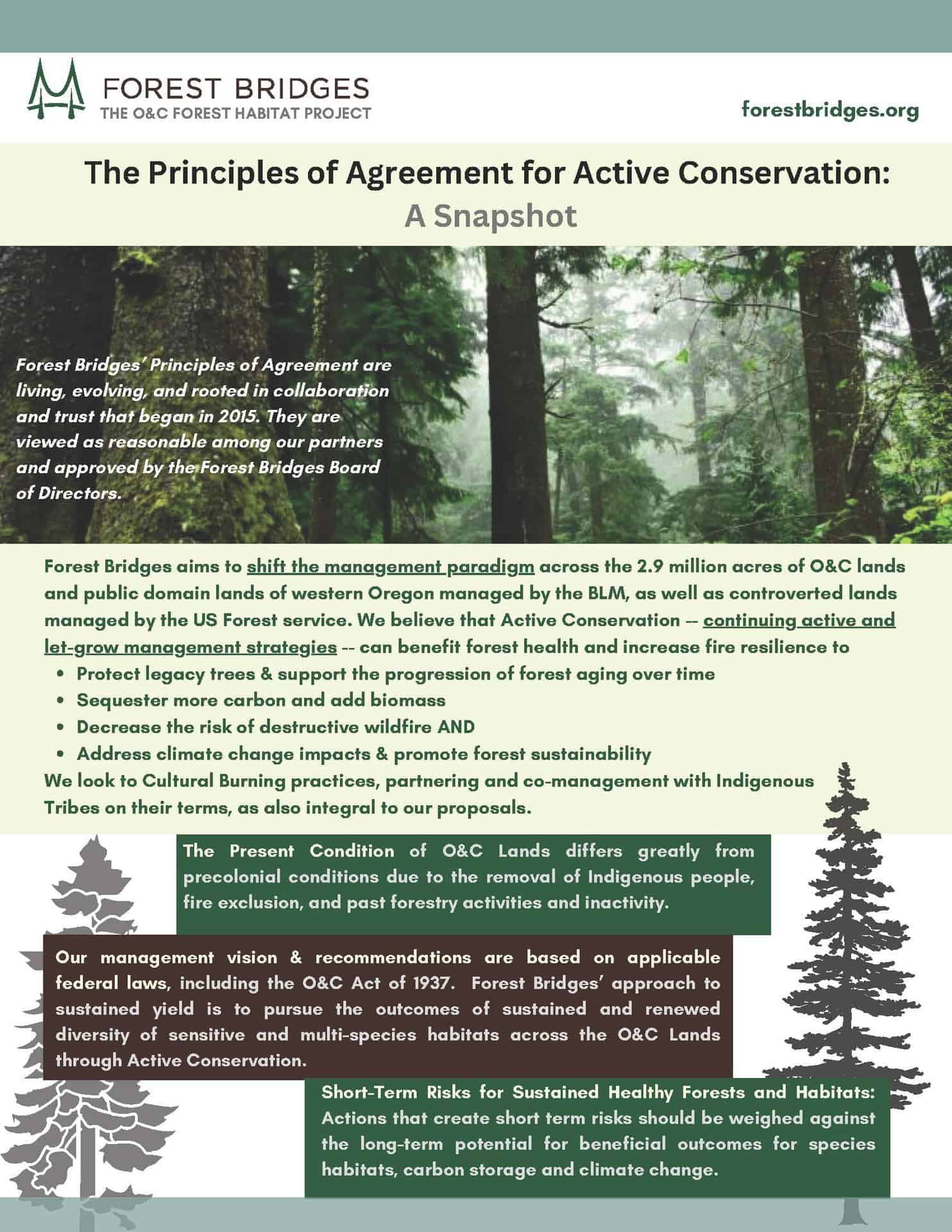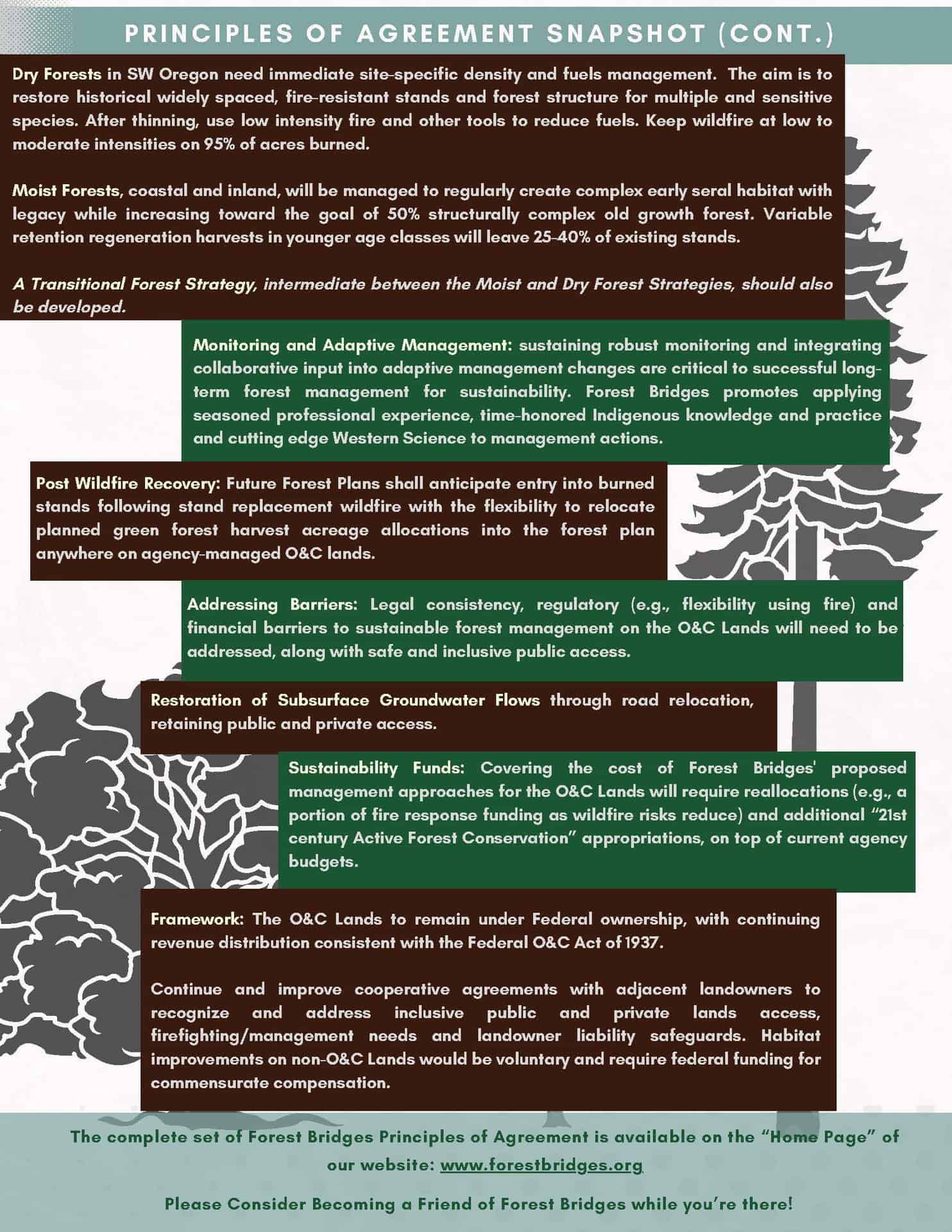 I’m always interested in people seeking agreement about forest issues, and Oregon seems to be a long-time source of ongoing controversy. Thanks to Nick Smith for this one.
I’m always interested in people seeking agreement about forest issues, and Oregon seems to be a long-time source of ongoing controversy. Thanks to Nick Smith for this one.
There was an interview on Jefferson Public Radio, but I couldn’t find it. Here’s the description.
The so-called “O&C lands” of Western Oregon have long been a focus of contention. They are lands once given by the federal government to the Oregon & California Railroad (O&C), taken back by the feds, then managed under law by the federal Bureau of Land Management.
The bone of contention comes from the sharing of timber receipts from those lands with the 18 O&C counties, which puts pressure on those lands to produce timber.
The nonprofit Forest Bridges proposes bringing the multiple sides of the debate together, to agree on timber cutting methods, and–more importantly–which land to include in the timber base. Forest Bridges Executive Director Denise Barrett gives us an interview with an overview.
Forest Bridges has a good website with lots of info. Their Principles of Agreement are here.

 Below is a snapshot of their principles of agreement. Feel free to discuss anything on the website in the comments.
Below is a snapshot of their principles of agreement. Feel free to discuss anything on the website in the comments.
Here’s what the O&C Act says, according to the BLM (https://www.blm.gov/sites/blm.gov/files/Oregon_Flyer.pdf):
History of the O&C Act
• The O&C Act provided for an initial annual timber harvest level of not less than 500 million board feet (MMBF) of timber until the annual sustained yield capacity of the lands could be determined. The declared annual sustained yield capacity for the Bureau of Land Management O&C lands has changed over time from 500 MMBF per year in 1937, to 1,185 MMBF per year in 1983, to 203 MMBF in 1995, (as prescribed under the Northwest Forest Plan) and to 205 MMBF under the 2016 plan. [FWIW, I colleague who worked for the BLM in Oregon told me some years ago that the O&C lands could easily produce 700+ MMBF/year on a sustainable basis.]
• The O&C Act also provided that 50% of receipts from the sale of O&C timber was to be distributed among the 18 O&C counties. An additional 25% of the receipts was to be distributed to the O&C counties after the U.S. Department of the Treasury was reimbursed for money advanced to make payments, in lieu of taxes, prior to 1937. The remaining 25% was to be paid into the U.S. Treasury by Congress (to be available upon appropriation) to administer O&C lands. Treasury was reimbursed for money advanced to make payments, in lieu of taxes, prior to 1937. The last 25 percent was to be paid into the Federal Treasury (to be available upon appropriation) by Congress to administer O&C lands.
One of the better approaches I have seen—questions who will participate in developing these concepts into a draft plan-how would it become a legal document which parties would abide by rather than lawsuits-the statement of increasing biomass will be in conflict with some of the practices to maintain stands in a healthy sustainable condition
For people with an unhealthy fascination with the O&C Act’s history, here are some additional resources:
o Original General Land Office regs implementing the act:
https://www.govinfo.gov/content/pkg/FR-1938-07-21/pdf/FR-1938-07-21.pdf
(beginning at pdf p.17)
o Association of O&C Counties history of the O&C Act (they love it): http://www.oandc.org/o-c-lands/history-of-o-c-lands/
o Michael Blumm’s take on the history of the act (he hates it): https://lawcommons.lclark.edu/cgi/viewcontent.cgi?article=1284&context=faculty_articles
Some of us here on TSW may have an unhealthy fascination with the O&C Act, but I, for one, see this as a law that ought to be followed or, if following the letter and intent of the law is no longer desired, then it ought to be changed. The Original General Land Office regs implementing the act — thanks you, Rich J! — make it clear that timber production was primary (“the productive capacity of the land”) and all other uses and values were important but secondary: “The Act refers to certain secondary benefits of the forest which are to be conserved by the new plan of management. It requires that the management practices employed shall provide agricultural opportunities, recreational facilities, water-shed protection, and stream-flow regulation.”
If the law no longer meets today’s needs, then the law ought to be changed, not misinterpreted.
This is a very fair point, but it has become very difficult to enact modern natural resource legislation. As I type this, several federal courts around the country are preparing to issue opinions citing one or more of FLPMA, NFMA, NEPA, ESA, and so on. These laws were written when push-button phones were the must-have home communications device. The O&C Act and the Taylor Grazing Act are old enough to be using walkers.
I don’t have an easy answer for this, but I was struck when I got into natural resources law many years ago how old the laws were then, and they haven’t gotten younger since. Yes, there has been some more recent forest management legislation (e.g., Quincy, HFRA, the odd FLPMA amendment) but (and I think I’m stealing Leshy’s metaphor here) these are merely a few turrets and gargoyles added haphazardly to the existing and increasingly moldering edifice.
Thank you, Rich!
“. . . the O&C lands could easily produce 700+ MMBF/year on a sustainable basis.” As compared to about 200/yr in more contemporary, holistic estimates. This is the rub. I may not doubt that 700 is attainable considering wood products primarily, but if you’re looking at the whole ecosystem, I’d go with the NWFP approach. Recent litigation outcomes support a holistic approach, too.
When you consider the counties that would be affected by this, it won’t be an easy sell – it is already difficult for the Forest Service to do stewardship sales in SW Oregon because the counties want the revenue from timber sales – they do not get that if it is a stewardship sale. Many of these counties were the first ones to fall into the Oregon “safety net” after timber harvest started to decline under the Northwest Forest Plan to ensure that their schools could still be funded.
I get hung up on the bias towards active management apparent in the first principle: “The present condition of O&C lands differs greatly from precolonial conditions due to the removal of Indigenous people, fire exclusion, and past forestry activities and inactivity.” And we know from recent court cases that a bias towards a particular level of sustained yield is not in the law.
This principle blames the change from precolonial conditions on “inactivity,” meaning there must have been active management in precolonial times. The only thing that could be referring to is Indigenous management, but removal of Indigenous people is listed as a separate cause. It also seems to be referring to a lack of “forestry activities,” which is not the way Indigenous management is usually referred to. I don’t think not doing something can be the cause of anything (forest succession would be the actual cause), but in any case, blaming the problem on doing nothing is of course going to bias the solution towards doing something.
“…counties want the revenue from timber sales” — Of course they do, especially in OR where timber receipts are hefty. BUT this approach proved to be unsustainable, and made logging heavily political. This was the reason a 10-yr “County Payments Bill” in early 2000s supplanted the 25% distribution that made counties dependent on federal logging. The aim was to acknowledge the historic contribution to roads and schools, but cut the tie to trees. IMO the largess flowing to big timber counties was very unfair to the have-nots.
Jim, other Regions have felt that way about the “largesse flowing to Region 6 and 5” 😉
The “rising tide” of huge timber programs floated many other boats. Coming to R6 from R2, the inequities were pretty huge
And Scott Fitzwilliams of the White River told us that going from R5 to R2 the inequities were also pretty huge, even in recreation.
The current interpretation of the O&C Act is embodied by the DC Circuit Court of Appeals in AFRC v USA, which the Supreme Court recently declined to review, so it stands as the law of the land.
The Court said “In sum, the O&C Act provides the Secretary with three layers of discretion: first, discretion to decide how land should be classified, which includes discretion to classify lands as timberland or not, second, discretion to decide how to balance the Act’s multiple objectives, and third, discretion to decide how to carry out the mandate that the land classified as timberland be managed for ‘permanent forest production.’”
The Court emphasized that the O&C Act has multiple purposes, not just “permanent forest production” but also protection of watersheds, regulation of streamflows, community economic stability, and recreation. The Court said, “The Act grants the Secretary discretion to decide how best to implement and balance these objectives.”
The Court also looked at the legislative history of the O&C Act, which showed that the law was intended to move away from forest liquidation and toward scientific principles of forest management which at that time included, “the ‘innovative’ principle of ‘sustained yield’ so that the land’s ‘natural assets could be conserved and perpetuated.’ … The goal of the O&C Act, then, was to ‘provide conservation and scientific management for this vast Federal property which now receives no planned management beyond liquidation of timber assets and protection from fire.’” The Court recognized the O&C Act as embodying scientific principles of conservation and as conservation science evolves, BLM has discretion to improve management in light of developing science.
This decision of the D.C. Circuit Court of Appeals is consistent with a long line of cases upholding the discretion of federal land management agencies, including another recent decision by the 9th Circuit Court of Appeals in Murphy Company v Biden. https://cdn.ca9.uscourts.gov/datastore/opinions/2023/04/24/19-35921.pdf
See Court opinion here https://www.cadc.uscourts.gov/internet/opinions.nsf/E6BF24352133254E852589F000547740/$file/20-5008-2008331.pdf